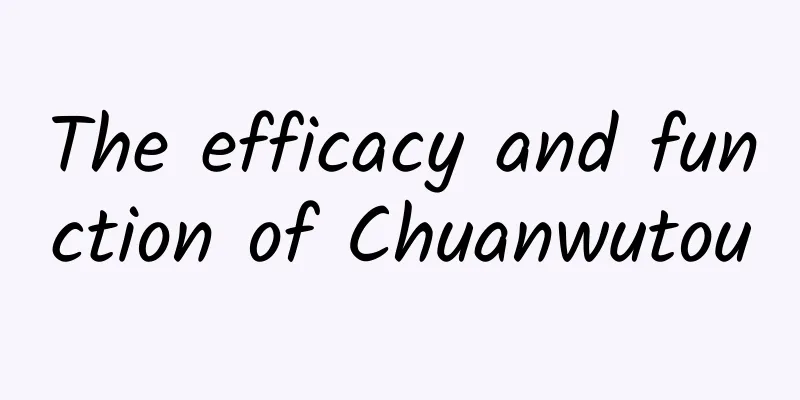The efficacy and function of Chuanwutou

|
The traditional Chinese medicine Chuanwutou is already very familiar to most people. But in fact, not many people understand the effects and functions of the traditional Chinese medicine Chuanwutou, so let’s talk about it below. [Other name] Chuanwu (Synopsis of the Golden Chamber) [Source] It is the tuberous root of Aconitum (cultivated product), a plant of the Ranunculaceae family. Dig out the whole plant between the Summer Solstice and the Lesser Heat, remove the above-ground stems and leaves, then pick off the sub-roots, separate them from the mother roots, shake off the soil, and dry them in the sun. 【Original form】 Aconitum (《本经》) [Habitat distribution] Mainly cultivated in Sichuan and Shaanxi. The wild species are distributed in Liaoning, Henan, Shandong, Shaanxi, Gansu, Jiangsu, Anhui, Zhejiang, Jiangxi, Fujian, Hunan, Hubei, Sichuan, Guizhou, Guangxi, Yunnan and other places. [Properties] Dry sub-roots, conical, 1.5 to 3 cm long and 1.5 to 2 cm in diameter. The surface is gray-brown with fine longitudinal wrinkles, a sunken bud mark on the top, and the sides often have traces of being picked from the mother root. The lower end is pointed, and there are several tumor-like raised lateral roots around it, commonly known as "nail horns". It is solid and hard to break. The outer layer of the cross section is brown, the inner layer is grayish white and powdery, and there is a polygonal ring mark on the cross section. Odorless, spicy and tongue-numbing taste. [Preparation] Raw Chuanwu: pick out impurities, wash off ash and dry in the sun. Preparation of Chuanwu: Clean Chuanwu and soak it in cold water, changing the water 2 to 3 times a day. Take it out when it has only a slight spicy taste in your mouth, add licorice and black beans and boil it together with water until the Chuanwu is cooked through and there is no white core inside. Remove the licorice and black beans, dry it in the sun, steam it until it is moist, slice it, and dry it in the sun (for every 100 kilograms of Chuanwu, use 6 kilograms of licorice and 10 kilograms of black beans). 【Nature and flavor】Pungent, hot, toxic. 【Meridian】 ①《Essential Chinese Medicines》: "Enters the Bi and Mingmen meridians." [Functions and indications] Dispel cold and dampness, disperse wind evil, warm the meridians, relieve pain, treat wind-cold and dampness arthralgia, rheumatoid arthritis, limb cramps, hemiplegia, headache, cold pain in the heart and abdomen, and swelling and toxins in the genitals. [Usage and Dosage] For oral use: decoct in water, 0.5-2 qian, or make into pills or powder. For external use: grind into powder and apply on skin. 【Note】 Do not take this medicine if you have Yin deficiency and Yang excess, or if you have fever and pain, or if you are pregnant. [Additional prescription] ① Treating wind-cold-dampness arthralgia, numbness and insensitivity: Chuanwu (raw, remove the skin and tip and grind into powder). Use half a bowl of fragrant cooked white rice porridge, four cents of medicinal powder, and cook with the rice over low heat. Make it thin, not thick. Add about a teaspoon of ginger juice and three tablespoons of honey, stir well, and sip it on an empty stomach. It is best to drink it while warm. If it is damp, add two cents of coix seed powder and increase the rice to make it a medium bowl of food. (Chuanwu porridge recipe from Benshi Fang) [Clinical Application] Used for mucosal surface anesthesia: Different dosage forms are prepared according to the physical and chemical properties of Aconitum and the purpose of anesthesia. 10% alcohol extract of Aconitum: Select large and high-quality raw Aconitum, grind it into fine powder, immerse it in 70% alcohol at a ratio of 10%, filter it for 24 hours and set aside (it should be freshly prepared and the usage time should not exceed 1 month). Mainly used for nasal and oral mucosa. When using, soak a cotton pad, wring it out slightly, and stick it to the area that needs anesthesia. The operation can be performed after 5 to 10 minutes. ㈡ Aconitum alcohol dilution: Add 10% Aconitum alcohol to distilled water or saline to prepare a 1.25% dilution (freshly prepared). Used for surface anesthesia of eyes, trachea and esophagus. When applying eye drops, patients may experience mild pain or a spicy sensation which disappears in an instant and is generally tolerable. Tracheal and esophageal anesthesia were performed according to general anesthesia methods. The operation can be performed after 5 to 10 minutes. ㈢ Aconitum glucose powder: Mix 1 part of very fine Aconitum powder with 9 parts of glucose powder. Its anesthetic effect is stronger than that of the extract and is not easy to lose its effect. During esophagoscopy and laryngoscopy, place the powder on the endoscope and swallow it slowly. The anesthetic effect is quite good. When used in the nasal cavity and oral cavity, the powder can be directly applied to the local mucosa with a cotton pad or cotton swab dipped in wet saline. For eye surgeries that take a long time, you can also sprinkle a small amount of powder on the conjunctival fornix of the lower eyelid and wait for it to dissolve on its own. The operation can be performed after 5 to 10 minutes. A total of 138 cases were observed using the three dosage forms mentioned above, with an anesthetic effectiveness rate of 97.1%, of which 85.5% were completely painless during the operation, 10.1% had mild pain during the operation but were able to complete the operation smoothly, and 1.4% had severe pain during the operation but were still able to complete the operation. Corneal foreign bodies were the most common ineffective cases, which might be due to insufficient anesthesia depth and the cornea being more sensitive than other tissues. No adverse reaction occurred during the application. [Remarks] Before the Ming Dynasty, Chuanwutou and Caowutou were mostly collectively referred to as Wutou. It was not until the Compendium of Materia Medica that a clear distinction was made, saying: "There are two kinds of Aconitum. The one produced in Zhangming is the mother of Aconitum, which is now called Sichuan Aconitum; the one produced in Jiangzuo, Shannan and other places is the Aconitum listed in the Ben Cao, which is now called Cao Wu Tou." This statement is basically consistent with the sources of the current commercial Sichuan Aconitum and Cao Wu Tou. However, the cultivation of Chuanwutou was first seen in "Compendium of Materia Medica", so the Chuanwutou mentioned before the Song Dynasty seemed to be wild Aconitum. See the entry for "Aconitum carmichaelii". 【Excerpt】 《*Dictionary》 [Source] From Hou Ningji's "Pharmacopoeia" and "Compendium of Materia Medica": There are two kinds of Aconitum. The one that comes out of Zhangming is the mother of Aconitum, which people now call Sichuan Aconitum. The fruit is born in late spring, so the fruit harvested in spring is called Aconitum. The fruit is already born in winter, so the fruit harvested in winter is called Aconite. Among them, Tianxiong, Wuhui and Cezi all give birth to many offspring and are named after their images. If there are few offspring or only one head, there will be no such species. The ones produced in Jiangzuo, Shannan and other places are the Aconitum listed in "Ben Cao", which is what people now call Aconitum carmichaelii. Therefore, it is said that the juice is boiled to make shewang. Hongjing did not know that there were two kinds of Aconitum, and he used the Aconitum from Fuzi as an injection for the Aconitum from Wang, which caused doubts among scholars. Before the Ming Dynasty, Chuanwutou and Caowutou were mostly collectively referred to as Wutou. To the Materia Medica Through the detailed introduction above, we have a good understanding of the efficacy and functions of the traditional Chinese medicine Chuanwutou. I hope this can be helpful to everyone. |
<<: The efficacy and function of Fubi
>>: The efficacy and function of roxburghii
Recommend
Big news! The top ten scientific advances in China in 2021 are announced
On February 28, the High Technology Research and ...
Effects and functions of Pinellia ternata
Pinellia ternata is a very common Chinese medicin...
"Only letting children learn Mathematical Olympiads will not cultivate them into mathematical masters"
27-year-old solves top math problems Won the worl...
What are the effects of boiling water with mugwort and honeysuckle?
Mugwort and honeysuckle are two very common Chine...
Are these 9.9 yuan free shipping headphones really usable? Will they damage your hearing?
On many shopping apps, when you search for "...
The efficacy and function of bitter candy
Bitter candy is a kind of traditional Chinese med...
Do you know that wolfberry soaked in water can nourish the kidneys?
Traditional Chinese medicine believes that wolfbe...
Lasting for more than 140 years and involving three generations of scientists, what exactly is this longest experiment in history studying?
Seeds are everywhere in our daily lives, from pea...
Is there another core hidden in the Earth's inner core?
The Earth is the common home of all living things...
Will AI understand the universe better than humans?
With the ability to quickly and accurately proces...
What are the medicinal values of black bone vine
Many people don’t know what black bone vine is. B...
The efficacy and function of Trachelospermum erythrorhizon
In our lives, Trachelospermum jasminoides has att...
The efficacy of drinking Uncaria rhynchophylla in water
Does anyone know what the effect of drinking Gast...









